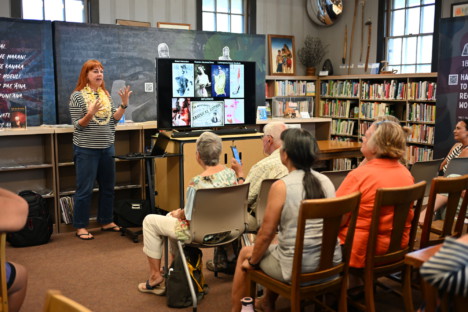Cara Lee Wade’s Photography Journey
By Léo Azambuja
At 19 years old, Cara Lee Wade’s life plan was to dance professionally, but a car accident robbed her of her dream. She then went on to devour an impressive variety of college classes, trying to figure out what was it that she wanted to do. Until she found photography.
“During my senior year of undergrad, I took a photography class, and the first time I put a piece of paper in the chemicals and an image showed up, my life has changed,” she said.
Wade recently finished a two-week art residency on the island, through a Molokai Arts Center program. During her time on Molokai, Wade created a series of prints using equipment and processes from a distant past.
“My specialty is 19th century photography with a 21st century spin. I like to add something contemporary to the older processes,” Wade said.
All her photos are shot on black-and-white film using a vintage 4×5 large-format camera. These cameras have two adjustable panels connected by bellows, giving them the ability to correct perspective or create intentional distortions, besides producing high-detailed images.
“My camera was created the same year my mom was born, which is intentional. When I saw that camera and learned about it, I was ‘Oh, that’s a connection,’” Wade said.
Her work tends to be about her family. As such, the beauty of Wades’s images and the introspective, autobiographic stories behind them denounce a poignant tale of her relationships with her family, with the world around her, and with herself.
“I call them self-portraits of other people. Because I become a representative of all the women in my family,” Wade said. She added that in most of her self-portraits, you cannot tell it is her in the photograph, “because they’re not intended to be me. They’re intended to be the women from my family.”
Wade also uses a technique to create images without a camera, called lumen photography. It is basically a camera-less process using sun exposure to create images on photographic paper.
Like in her photos shot with a 4×5 large-format camera, she also uses black-and-white photo paper when she does the lumen process. But unlike her work shot with a camera, the color spectrum on her lumen photography hits high notes.
“All my colors are in my lumens,” she said.
She arranges plants on the photo paper, and set it in the sun to be exposed.
“I use these household materials — pigments and liquids — and they create a chemical reaction with the plants and the paper, which creates color,” Wade said.
Because the prints from this organic process are ephemeral, Wade scans them and has them printed on large metal sheets, where they become permanent.
As a child, Wade moved quite often because her father was in the military. She spent a few years on Oahu. Since moving away, she came back once to Hawaii, but had never been to Molokai until now.
She said she was inspired by the landscape and the plants to create art, and was touched by the island residents.
“I felt a real connection to the people. Their love of the island, I feel like it radiated off of everyone, and it kind of sucked me in,” Wade said.
While on Molokai, she put out about 75 lumens, and two dozen will be final pieces. She also shot photographs with her 4×5 camera, and she thinks at least five of them will be keepers.
In November, Wade has a show scheduled in a university in Hartford, Conn., and she intends to include a Molokai piece, she said.
Before leaving the island, Wade wrapped her stay with a talk session at Molokai Public Library July 23, when at least a dozen people attended to hear her stories.
“I want to thank Molokai for their hospitality. I have felt so welcomed and just taken care of since I have been here,” she said.
Visit www.caraleewade.com and www.molokaiartscenter.org for more information.












Don't have a Molokai Dispatch ID?
Sign up is easy. Sign up now
You must login to post a comment.
Lost Password